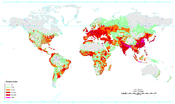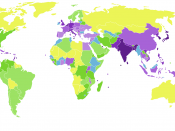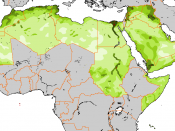These factors expressed in the question affect the population density of a country or location immensely.
Firstly relief, when we talk about the relief we talk about highlands and lowlands. Although immediately we like to think that most of the world's population live fairly low down it is in fact the case that 80% of the worlds population live 500 metres above the sea level, this is actually fairly high up. What we might have been thinking of are the mountainous areas of the world like the Andes, Nepal or the Himalayas, these areas are sparsely populated due to the poor soils, low temperatures and high rainfall. Lowlands on the other hand are much more amiable, the land is easily farmed and easy to build on, much more appropriate for settlement; there are also higher temperatures and potentially less rainfall. Netherlands is a prime example of this: although a small country because of the relief it is highly populated meaning that the density is high as well (469 people/km2).
Almost fundamental to population density is the climate. The climate allows you or prohibits you to farm or build up secondary and tertiary industries. The facts about climate are that 80% of the world's population live between 20 degrees north and south of the equator. Areas which have low population densities are like the Sahara because of the fact that it gets 40mm of rain a year, but also areas of high humidity like the Amazon basin, and then rather obviously low temperatures like in North Canada in the tundra. In the temperate and moderate climate areas of the world population density is much higher, this is due to the reasonable rainfall and temperatures or if you have high temperature and high rainfall (allows for double cropping).
SE Asia is a prime location of where double cropping takes place, and Europe in general and specifically the UK have average rainfall and temperatures, this is shown in its population density of over 200 persons per kilometre squared.
And finally soils which at first may not seem very important but it is in fact crucial. Northern Canada is covered in tundra; this makes it very difficult to build on especially when there is permafrost as well. It also makes it almost impossible to farm as there are no nutrients in the "almost ice". Mountain ranges wouldn't be that bad to live on bar that fact that soils are so acidic due to surface runoff and the rock types; this means farming is out of the question as nothing will grow on the harsh slopes; this is why Nepal has such a low density, because the country is so mountainous. The rainforests of South America are sparsely populated due to the leached soils; all the nutrients are sucked out.
In comparison the humus filled soils of the Ganges delta and the American prairies are perfect soils for farming and growing on; the Ganges more so because of the river deposited silt and alluvium.
In conclusion the highest population densities of the world are Europe, India and East America. These countries or continents have high densities because they have the qualities given above or by some other economical reason.




